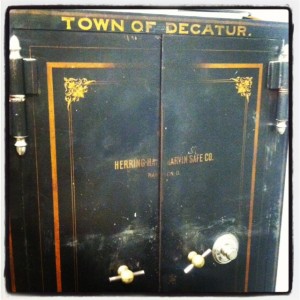Most of you know that Decatur has a long and rich history, dating back to the early nineteenth century. Over the years, the City has made an effort to preserve the historic documents that help tell Decatur’s story. These documents include everything from cemetery records to school records dating back to the late nineteenth century to City Commission meeting minutes, and even scrapbooks detailing Decatur’s political history. Currently, efforts are being made to have some of these records digitized and made more accessible to the public. For now, if you are interested in learning more about Decatur’s history, you can access the City’s collection at DeKalb History Center, through Ancestry.com. Here you will find hundreds of documents, many from the late nineteenth and early twentieth centuries, all the way up to the 1980s. Documents include building permits, cemetery purchases, City Clerk records from the 1890s, news from Decatur churches, and meeting minutes detailing the activities of the police and fire departments, the school system, and the City library. Records are indexed and searchable by name, so if you are looking for information on a particular Decatur politician or officer, you just might be able to find it. There are some interesting tidbits to be found. For instance, in April 1939 the City received a letter from the Secretary of Ripley’s Believe It or Not, Louise Ripley, “requesting a snapshot of (Decatur’s) White Street as Mr. Ripley had been informed that no white person lives there, only negro families.” The record notes that the photo was sent as requested. Another interesting record, from February 1920, is a motion to hire an architect to provide plans for the future City Hall, a project with a budget of $20,000- hard to believe today. These records provide a fascinating glimpse into Decatur’s past and offer endless research possibilities.
Anyone interested in searching Decatur’s online records can find them at http://publish.ancestry.com/Collection/102794/Gallery or through DeKalb History Center’s Ancestry.com collection at http://publish.ancestry.com/Group/100907/Profile.

I’m guessing that no one gave the Ripley’s anecdote any serious thought. So in 1939, Ripley’s Believe it or Not found Decatur’s segregated Jim Crow housing pattern ironic because the city had a street named “White” with no African Americans living in it? And you’re proud of that? The least you could have done in this post is added some context to the Ripley’s letter.
Certainly we are aware of the context of the time period of Jim Crow. The blog is meant to point out various areas for potential research- this document was chosen as one that contains historical, racial, and cultural undertones and could be used to illustrate the time period in a variety of ways.
Don’t take him seriously, Jessica. Dave’s just in the habit of criticizing everyone who writes about Decatur and doesn’t mention him.
Interesting piece. Nice to know these resources are available.
Interesting read! These old docs are so fascinating. And I love that more and more of them are accessible online.
If you say so Jessica. From my vantage point, very little has changed in Decatur from 1939. One need only look so far as the monochromatic comprehensive historic resource survey the city did in 2009 that, like White Street, was devoid of African Americans.
Seems you have a very narrow vantage point, then, Dave. Perhaps you should open your eyes (and your mind) a bit.